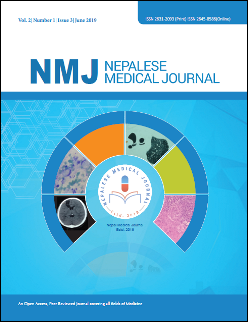Sleep Disordered Breathing in Patient with Type 2 Diabetes Mellitus and its Association with Diabetic Retinopathy: Single Center Study
DOI:
https://doi.org/10.3126/nmj.v2i1.23546Keywords:
Apnea, Diabetes, Glycosylated, Haemoglobin, Obstructive sleep apnea, Polysomnography, RetinopathyAbstract
Introduction: Sleep-disordered breathing comprises of obstructive sleep apnea, central sleep apnea, and periodic breathing. There is a link between obesity diabetes and sleep apnea with its association with retinopathy. Therefore this study was done to find out the association of sleep-disordered breathing in uncontrolled diabetes mellitus and association with retinopathy.
Materials and Methods: This study was done from 2015 September to 2018 September in Sleep center, Nepal. Patients diagnosed with Type 2 diabetes mellitus were included. Diabetes mellitus was diagnosed as blood sugar fasting ≥ 126mg/dl, or blood sugar postprandial ≥200mg/dl and glycosylated hemoglobin above 6.5%. Obstructive sleep apnea risk was determined using the STOP-BANG questionnaire. Relationships between the risk of Obstructive sleep apnea and clinical variables along with its association with diabetic retinopathy were evaluated using bivariate analyses and covariate-adjusted logistic regression models.
Results: A total of 150 diabetic patients were analyzed. Among them 30 (20.0%) patients had mild Obstructive sleep apnea, 14 (9.3%) patients had moderate Obstructive sleep apnea and 15 (10.0%) patients had severe sleep apnea. Among patients with diabetes mellitus on multivariate regression analysis Obstructive sleep apnea was associated with diabetes mellitus OR 2.05, 95% CI (1.69- 8.83) and diabetic retinopathy OR 1.20 (0.67-5.89).
Conclusions: This study concludes that those individuals having diabetes may be suffering from obstructive sleep apnea and association with retinopathy these individuals can be considered for the screening of sleep-disordered breathing by polysomnography.
Downloads
Downloads
Published
How to Cite
Issue
Section
License
This license enables reusers to distribute, remix, adapt, and build upon the material in any medium or format, so long as attribution is given to the creator. The license allows for commercial use.
Copyright on any article published by Nepalese Medical Journal is retained by the author(s).
Authors grant Nepalese Medical Journal a license to publish the article and identify itself as the original publisher.
Authors also grant any third party the right to use the article freely as long as its integrity is maintained and its original authors, citation details and publisher are identified.




